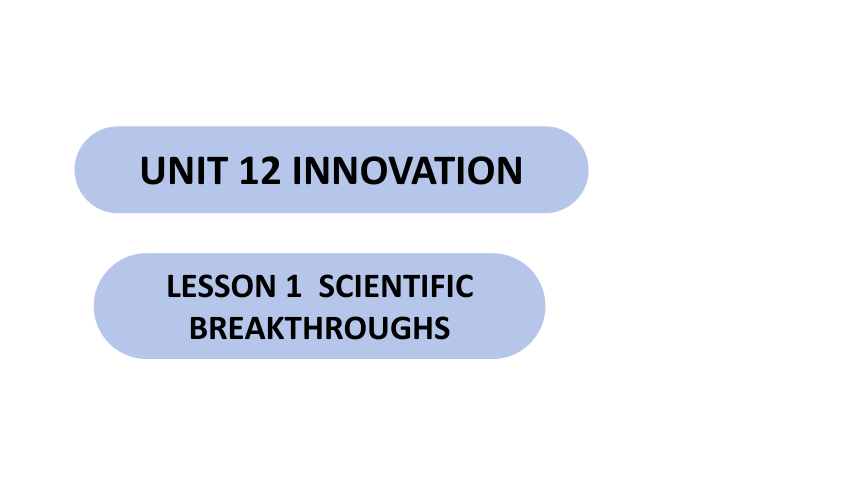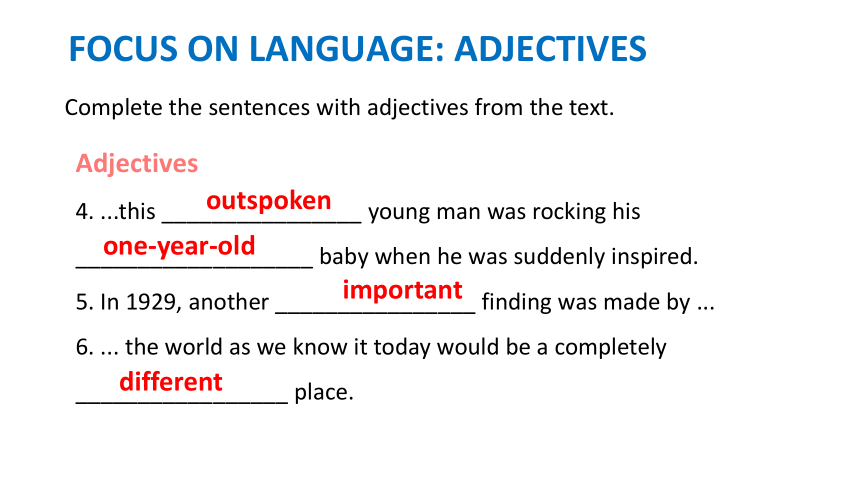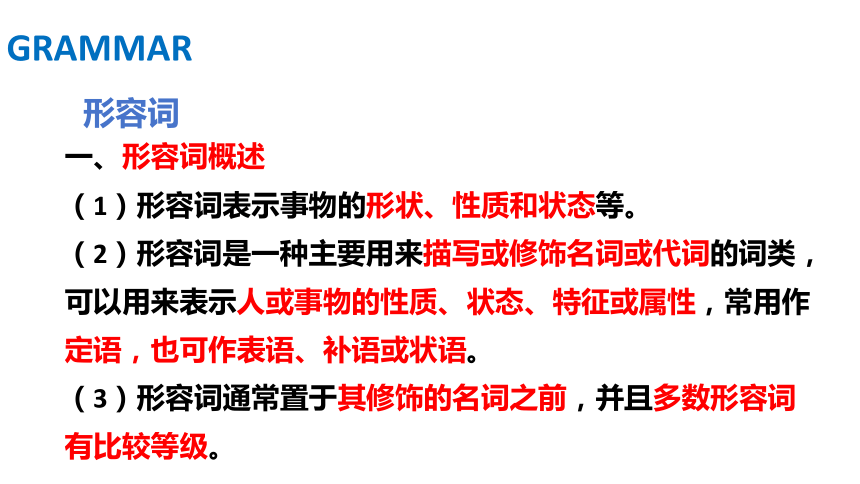UNIT 12 INNOVATION LESSON 1课件(共39张,内嵌视频)-高中英语北师大版(2019)选择性必修第四册
文档属性
| 名称 | UNIT 12 INNOVATION LESSON 1课件(共39张,内嵌视频)-高中英语北师大版(2019)选择性必修第四册 |  | |
| 格式 | pptx | ||
| 文件大小 | 5.1MB | ||
| 资源类型 | 教案 | ||
| 版本资源 | 北师大版(2019) | ||
| 科目 | 英语 | ||
| 更新时间 | 2025-04-01 20:35:20 | ||
图片预览












文档简介
(共39张PPT)
LESSON 1 SCIENTIFIC BREAKTHROUGHS
UNIT 12 INNOVATION
LEARNING OBJECTIVES
To read and talk about important inventions and discoveries of the 20th century;
To read for general understanding;
To read for specific information to understand words in context;
To understand and learn words and expressions in context;
To compare personal opinions with the ideas of others;
To write a summary of an important discovery or invention;
To learn and practise using adjectives.
KEY POINTS AND DIFFICULT POINTS
To answer the comprehension questions;
To think about important inventions and discoveries of the 20th century;
To match the discoveries or inventions with how they came about;
To struggle with complicated sentence structures;
To think critically and express opinions freely;
To compare personal opinions with the ideas of others.
LEADING IN
What are the functions of the underlined adjectives
1. The robotic vacuum cleaner, designed to make cleaning easier, has simplified household chores.
2. Tired and hungry, the inventor took a well-deserved rest after completing the design for the robotic vacuum cleaner.
Complement
Adverbial
An adjective can be used as attribute, adverbial, predictiveand complement.
FOCUS ON LANGUAGE: ADJECTIVES
Complete the sentences with adjectives from the text.
Adjectives
1. If you had to choose the _____________ most important discovery of the 20th century ...
2. ... the way we correspond went from writing letters to emailing and sending _____________ messages.
3. ... it is ______________ to single out a few pioneers of the 20th century.
single
instant
possible
FOCUS ON LANGUAGE: ADJECTIVES
Complete the sentences with adjectives from the text.
Adjectives
4. ...this ________________ young man was rocking his ___________________ baby when he was suddenly inspired.
5. In 1929, another ________________ finding was made by ...
6. ... the world as we know it today would be a completely _________________ place.
outspoken
one-year-old
important
different
FOCUS ON LANGUAGE: ADJECTIVES
Complete the sentences with adjectives from the text.
1. That is a really ________________ (wooden, ugly) chair.
2. She was wearing a ________________ (silk, new, red) dress.
3. There are ______________________ (new, Chinese, some) students in the class.
4. I have _______________________________ (white gold, two, old, beautiful) necklaces.
5. I bought a __________________________ (cotton, sun, short, green) dress for the wedding.
ugly wooden
new red silk
some new Chinese
two beautiful old white gold
short green cotton sun
FOCUS ON LANGUAGE: ADJECTIVES
Study the sentences in Activity 9. Answer the questions.
If there is more than one adjective before a noun, opinion adjectives usually go before fact adjectives. (e.g. single most important discovery).
1. If there is more than one adjective before a noun, what is the order of the adjectives
Adverbs can modify adjectives.
2. What words can be used to modify adjectives
FOCUS ON LANGUAGE: ADJECTIVES
Study the sentences in Activity 9. Answer the questions.
For example, "one-year-old" and "strong-willed" are compound adjectives. They are formed when two or more adjectives are joined together by one or more hyphens.
3. Find some compound adjectives. How are they formed
FOCUS ON LANGUAGE: ADJECTIVES
Study the sentences in Activity 9. Answer the questions.
Adjectives that show quality, opinion, size, shape or colour are comparable. Adjectives that show quantity, number, nationality or material are non-comparable.
4. Which of the adjectives are comparable adjectives Which are non-comparable adjectives
GRAMMAR
形容词
一、形容词概述
(1)形容词表示事物的形状、性质和状态等。
(2)形容词是一种主要用来描写或修饰名词或代词的词类,可以用来表示人或事物的性质、状态、特征或属性,常用作定语,也可作表语、补语或状语。
(3)形容词通常置于其修饰的名词之前,并且多数形容词有比较等级。
GRAMMAR
形容词
二、形容词的句法功能
(1)作定语。(前置定语或后置定语)
This is a book suitable for children. 这是一本适合孩子们的书。
Do you have anything important to tell me
你有什么重要的事情要告诉我吗?
He has worked as a teacher in a remote area since he graduated from college.
他大学毕业后一直在偏远地区当老师。
GRAMMAR
形容词
二、形容词的句法功能
(2)作状语。用来说明主语的情况,表示原因、结果、伴随、时间、条件或方式,可位于句首、句中或句末,一般用逗号将其与其他部分隔开
He returned home, safe and sound.
他回到了家,安然无恙。
Careful with money, my mother managed to send me to college.
妈妈小心地用着钱,把我送去上了大学。
GRAMMAR
形容词
二、形容词的句法功能
(3)作表语。位于系动词be, feel, get, become, turn, prove, seem等之后
His suggestions are very valuable. 他的建议很有价值。
He felt ashamed of what he had done to his friend.
他为自己对朋友所做的事感到羞愧。
The painting is not representative of his work of the period.
这幅画并不能代表他在那个时期的作品。
GRAMMAR
形容词
二、形容词的句法功能
(4)作宾语补足语。
I consider his suggestion very helpful.
我认为他的建议很有帮助。
Please keep the classroom clean and tidy.
请保持教室干净、整洁。
Doing regular exercise can help to make one energetic.
做有规律的锻炼可以帮助使一个人精力充沛。
GRAMMAR
形容词
三、形容词的构词方法
(1)形容词+名词+-ed
good-tempered 好脾气的;noble-minded 高尚的
(2)形容词+现在分词
good-looking 长得好看的;easy-going 容易相处的
(3)副词+现在分词
hard-working 努力工作的;far-reaching(影响)深远的
(4)名词+过去分词
heart-felt 衷心的;state-owned 国有的
GRAMMAR
形容词
三、形容词的构词方法
(5)名词+现在分词
peace-loving 爱好和平的;epoch-making 划时代的
(6)副词+过去分词
well-known 著名的;widespread 分布广泛的
(7)形容词+过去分词
kind-hearted 好心肠的;ready-made 做好的,现成的
(8)名词+形容词
self-confident 自信的;self-satisfied 自我满足的;自负的
GRAMMAR
形容词
四、形容词的常用后缀
(1)-ful 充满……的;有……性质(或倾向)的
useful 有用的;successful 成功的
(2)-y 多……的
healthy 健康的;wealthy 富有的
(3)-ly 以……方式;具有……性质
friendly 友好的;brotherly 情同手足的
(4)-able/ -ible 能……的,可以……的
valuable 有价值的;possible 可能的
GRAMMAR
形容词
四、形容词的常用后缀
(5)-ant/ -ent 是……的;处于……状态
important 重要的;frequent 频繁的
(6)-ous 有……性质的
dangerous 危险的;glorious 光荣的
(7)-ish 有……性质的;像……似的
childish 孩子气的;foolish 愚蠢的
(8)-less 无……的,没有……的
harmless 无害的;helpless 无助的
GRAMMAR
形容词
四、形容词的常用后缀
(9)-ary/ -ory 与……有关的
imaginary 想象的;contradictory 矛盾的
(10)-al 与……有关的(表示过程或状态)
cultural 文化的;natural 自然的
(11)-ic 与……有关的;动作……(或行为)的
historic 历史上的;heroic 英雄的
(12)-tive 有……倾向的;有……属性的
effective 有效的;constructive 建设性的
GRAMMAR
形容词
四、形容词的常用后缀
(13)-(e)d 有……的;以……为特征的
limited 有限的;pointed 尖的
(14)-like 像……的
childlike 孩子般的;dreamlike 如梦般的
(15)-some 引起(或易于)……的
troublesome 引起麻烦的;tiresome 令人厌恶的
(16)-ar 带有……属性的
regular 规则的;circular 圆的
GRAMMAR
形容词
五、形容词的原级
1. 肯定句用“as+形容词原级+as…”结构
My handwriting is as beautiful as yours.
我的书法和你的一样好。
2. 否定句用“not as/ so+形容词/副词原级+as…”结构
I am not as/ so busy as I used to be.
我没有过去那么忙了。
GRAMMAR
形容词
五、形容词的原级
3. as+形容词原级+as+数量词 = 数量词+形容词
The building is as tall as 100 meters. =The building is 100 meters tall. 这个建筑有100米高。
4. as+形容词原级+a/ an+单数名词+as
as+many+复数名词+as as+much+不可数名词+as
John doesn't have as much money as Helen.
约翰没有海伦有钱。
GRAMMAR
形容词
六、形容词的比较级和最高级
(1)一般单音节词和少数以-er, -ow结尾的双音节词,比较级在后面加-er,最高级在后面加-est
① 单音节词
small—smaller—smallest;short—shorter—shortest;
great—greater—greatest
② 双音节词
clever—cleverer—cleverest;narrow—narrower—narrowest
GRAMMAR
形容词
六、形容词的比较级和最高级
(2) 以不发音的字母e结尾的单音节词,比较级在原级后加-r,最高级在原级后加-st
large—larger—largest;nice—nicer—nicest;able—abler—ablest;brave—braver—bravest;wide—wider—widest
(3) 重读闭音节(辅元辅)先双写末尾的辅音字母,比较级加-er,最高级加-est
big—bigger—biggest;fat—fatter—fattest;hot—hotter—hottest
GRAMMAR
形容词
六、形容词的比较级和最高级
(4)辅音字母+-y结尾的双音节词,把y改为i,比较级加-er,最高级加-est
easy—easier—easiest;heavy—heavier—heaviest;
busy—busier—busiest;happy—happier—happiest
It'll have to wait. This is our busiest time
这事得往后放。这是我们最忙碌的时候。
GRAMMAR
形容词
六、形容词的比较级和最高级
(5)其他双音节词和多音节词,比较级在前面加more,最高级在前面加 most
beautiful—more beautiful—most beautiful;different—more different—most different;
popular—more popular—most popular;difficult—more difficult—most difficult;
expensive—most expensive—more expensive
GRAMMAR
形容词
七、形容词的位置
(1)一般情况下,形容词作定语时,放在被修饰词之前,形容词短语作定语时,要放在被修饰词之后
I like your down-to-earth and hardworking spirit.
我就喜欢你们这股扎扎实实埋头苦干的劲儿。
It didn't make use of long muscles we used to throw a baseball, and it wasn't a smooth operation like ice-skating.
它并没有利用我们投掷棒球时使用的长肌,也不像滑冰那样平稳运转。
GRAMMAR
形容词
七、形容词的位置
(2)形容词一般作前置定语,但在下列情况下,形容词要放在被修饰词后面
① 形容词作定语修饰由some-, any-, every-, no-和-body, -thing, -one等构成的复合不定代词时,需后置
There is nobody absent today.
今天没有人缺席。
GRAMMAR
形容词
七、形容词的位置
(2)形容词一般作前置定语,但在下列情况下,形容词要放在被修饰词后面
② 一些表语形容词作定语时,常放在被修饰词的后面,如alive, alike, awake, asleep, alone等
On the American continents, Canada and Argentina alone have succeeded.
在美洲大陆,只有加拿大和阿根廷取得了成功。
GRAMMAR
形容词
七、形容词的位置
(2)形容词一般作前置定语,但在下列情况下,形容词要放在被修饰词后面
③ 成对的形容词可以后置
He was hardworking and energetic.
他工作努力,精力充沛。
There was a huge room, simple and beautiful.
有一个大房间,简单且漂亮。
GRAMMAR
形容词
七、形容词的位置
(2)形容词一般作前置定语,但在下列情况下,形容词要放在被修饰词后面
④ 当“形容词+不定式”构成的短语作定语时,需后置
The teacher asked me a question too difficult to answer.
老师问了我一个难得回答的问题。
A man so difficult to please must be hard to work with.
一个如此难以取悦的人一定很难共事。
GRAMMAR
形容词
七、形容词的位置
(2)形容词一般作前置定语,但在下列情况下,形容词要放在被修饰词后面
⑤ 当含有old, long, high, wide, deep等词的数量词短语作定语时,需后置
At that time she was only a girl five years old.
那时,她只是一个5岁的小女孩。
PRACTICE
1. The Wallace giant bee is the world’s _______________(large) bee, with a body the size of a human thumb and wings that can spread to about 2.5 inches.
2. He is a little weak in all his subjects but he is _______________ (gift) in dancing and singing.
3. The doctor explained the situation to her little brother, and asked the little boy if he would be _______________ (will) to give his blood to his sister.
largest
gifted
willing
PRACTICE
4. “We are now thinking about development, allowing the paintings to be more _______________ (create),” he said.
5. It is one of the most _______________ (amaze) TV shows from an artistic point of view.
6. He is so _______________ (sorrow) because he can’t go to the graduation ceremony because of his illness.
7. This gives the brightest and best students an opportunity to experience the benefits of studying at a _______________ (globe) Top 100 university.
creative
amazing
sorrowful
global
PRACTICE
8. After all, family bonds are the most _________________ (significance) thing in Chinese people’s hearts.
9. The study showed that those who had worked as boys enjoyed happier and _______________________ (productive) lives than those who had not.
10. Frank put the medicine in the top drawer to make sure it would not be ________________ (access) to the kids.
11. It isn’t socially _________________ (accept) for parents to leave children unattended at that age.
significant
more productive
accessible
acceptable
SUMMARY
Read and talk about important inventions and discoveries of the 20th century;
Read for general understanding;
Read for specific information to understand words in context;
Understand and learn words and expressions in context;
Compare personal opinions with the ideas of others;
Write a summary of an important discovery or invention;
Learn and practise using adjectives.
Thank you
LESSON 1 SCIENTIFIC BREAKTHROUGHS
UNIT 12 INNOVATION
LEARNING OBJECTIVES
To read and talk about important inventions and discoveries of the 20th century;
To read for general understanding;
To read for specific information to understand words in context;
To understand and learn words and expressions in context;
To compare personal opinions with the ideas of others;
To write a summary of an important discovery or invention;
To learn and practise using adjectives.
KEY POINTS AND DIFFICULT POINTS
To answer the comprehension questions;
To think about important inventions and discoveries of the 20th century;
To match the discoveries or inventions with how they came about;
To struggle with complicated sentence structures;
To think critically and express opinions freely;
To compare personal opinions with the ideas of others.
LEADING IN
What are the functions of the underlined adjectives
1. The robotic vacuum cleaner, designed to make cleaning easier, has simplified household chores.
2. Tired and hungry, the inventor took a well-deserved rest after completing the design for the robotic vacuum cleaner.
Complement
Adverbial
An adjective can be used as attribute, adverbial, predictiveand complement.
FOCUS ON LANGUAGE: ADJECTIVES
Complete the sentences with adjectives from the text.
Adjectives
1. If you had to choose the _____________ most important discovery of the 20th century ...
2. ... the way we correspond went from writing letters to emailing and sending _____________ messages.
3. ... it is ______________ to single out a few pioneers of the 20th century.
single
instant
possible
FOCUS ON LANGUAGE: ADJECTIVES
Complete the sentences with adjectives from the text.
Adjectives
4. ...this ________________ young man was rocking his ___________________ baby when he was suddenly inspired.
5. In 1929, another ________________ finding was made by ...
6. ... the world as we know it today would be a completely _________________ place.
outspoken
one-year-old
important
different
FOCUS ON LANGUAGE: ADJECTIVES
Complete the sentences with adjectives from the text.
1. That is a really ________________ (wooden, ugly) chair.
2. She was wearing a ________________ (silk, new, red) dress.
3. There are ______________________ (new, Chinese, some) students in the class.
4. I have _______________________________ (white gold, two, old, beautiful) necklaces.
5. I bought a __________________________ (cotton, sun, short, green) dress for the wedding.
ugly wooden
new red silk
some new Chinese
two beautiful old white gold
short green cotton sun
FOCUS ON LANGUAGE: ADJECTIVES
Study the sentences in Activity 9. Answer the questions.
If there is more than one adjective before a noun, opinion adjectives usually go before fact adjectives. (e.g. single most important discovery).
1. If there is more than one adjective before a noun, what is the order of the adjectives
Adverbs can modify adjectives.
2. What words can be used to modify adjectives
FOCUS ON LANGUAGE: ADJECTIVES
Study the sentences in Activity 9. Answer the questions.
For example, "one-year-old" and "strong-willed" are compound adjectives. They are formed when two or more adjectives are joined together by one or more hyphens.
3. Find some compound adjectives. How are they formed
FOCUS ON LANGUAGE: ADJECTIVES
Study the sentences in Activity 9. Answer the questions.
Adjectives that show quality, opinion, size, shape or colour are comparable. Adjectives that show quantity, number, nationality or material are non-comparable.
4. Which of the adjectives are comparable adjectives Which are non-comparable adjectives
GRAMMAR
形容词
一、形容词概述
(1)形容词表示事物的形状、性质和状态等。
(2)形容词是一种主要用来描写或修饰名词或代词的词类,可以用来表示人或事物的性质、状态、特征或属性,常用作定语,也可作表语、补语或状语。
(3)形容词通常置于其修饰的名词之前,并且多数形容词有比较等级。
GRAMMAR
形容词
二、形容词的句法功能
(1)作定语。(前置定语或后置定语)
This is a book suitable for children. 这是一本适合孩子们的书。
Do you have anything important to tell me
你有什么重要的事情要告诉我吗?
He has worked as a teacher in a remote area since he graduated from college.
他大学毕业后一直在偏远地区当老师。
GRAMMAR
形容词
二、形容词的句法功能
(2)作状语。用来说明主语的情况,表示原因、结果、伴随、时间、条件或方式,可位于句首、句中或句末,一般用逗号将其与其他部分隔开
He returned home, safe and sound.
他回到了家,安然无恙。
Careful with money, my mother managed to send me to college.
妈妈小心地用着钱,把我送去上了大学。
GRAMMAR
形容词
二、形容词的句法功能
(3)作表语。位于系动词be, feel, get, become, turn, prove, seem等之后
His suggestions are very valuable. 他的建议很有价值。
He felt ashamed of what he had done to his friend.
他为自己对朋友所做的事感到羞愧。
The painting is not representative of his work of the period.
这幅画并不能代表他在那个时期的作品。
GRAMMAR
形容词
二、形容词的句法功能
(4)作宾语补足语。
I consider his suggestion very helpful.
我认为他的建议很有帮助。
Please keep the classroom clean and tidy.
请保持教室干净、整洁。
Doing regular exercise can help to make one energetic.
做有规律的锻炼可以帮助使一个人精力充沛。
GRAMMAR
形容词
三、形容词的构词方法
(1)形容词+名词+-ed
good-tempered 好脾气的;noble-minded 高尚的
(2)形容词+现在分词
good-looking 长得好看的;easy-going 容易相处的
(3)副词+现在分词
hard-working 努力工作的;far-reaching(影响)深远的
(4)名词+过去分词
heart-felt 衷心的;state-owned 国有的
GRAMMAR
形容词
三、形容词的构词方法
(5)名词+现在分词
peace-loving 爱好和平的;epoch-making 划时代的
(6)副词+过去分词
well-known 著名的;widespread 分布广泛的
(7)形容词+过去分词
kind-hearted 好心肠的;ready-made 做好的,现成的
(8)名词+形容词
self-confident 自信的;self-satisfied 自我满足的;自负的
GRAMMAR
形容词
四、形容词的常用后缀
(1)-ful 充满……的;有……性质(或倾向)的
useful 有用的;successful 成功的
(2)-y 多……的
healthy 健康的;wealthy 富有的
(3)-ly 以……方式;具有……性质
friendly 友好的;brotherly 情同手足的
(4)-able/ -ible 能……的,可以……的
valuable 有价值的;possible 可能的
GRAMMAR
形容词
四、形容词的常用后缀
(5)-ant/ -ent 是……的;处于……状态
important 重要的;frequent 频繁的
(6)-ous 有……性质的
dangerous 危险的;glorious 光荣的
(7)-ish 有……性质的;像……似的
childish 孩子气的;foolish 愚蠢的
(8)-less 无……的,没有……的
harmless 无害的;helpless 无助的
GRAMMAR
形容词
四、形容词的常用后缀
(9)-ary/ -ory 与……有关的
imaginary 想象的;contradictory 矛盾的
(10)-al 与……有关的(表示过程或状态)
cultural 文化的;natural 自然的
(11)-ic 与……有关的;动作……(或行为)的
historic 历史上的;heroic 英雄的
(12)-tive 有……倾向的;有……属性的
effective 有效的;constructive 建设性的
GRAMMAR
形容词
四、形容词的常用后缀
(13)-(e)d 有……的;以……为特征的
limited 有限的;pointed 尖的
(14)-like 像……的
childlike 孩子般的;dreamlike 如梦般的
(15)-some 引起(或易于)……的
troublesome 引起麻烦的;tiresome 令人厌恶的
(16)-ar 带有……属性的
regular 规则的;circular 圆的
GRAMMAR
形容词
五、形容词的原级
1. 肯定句用“as+形容词原级+as…”结构
My handwriting is as beautiful as yours.
我的书法和你的一样好。
2. 否定句用“not as/ so+形容词/副词原级+as…”结构
I am not as/ so busy as I used to be.
我没有过去那么忙了。
GRAMMAR
形容词
五、形容词的原级
3. as+形容词原级+as+数量词 = 数量词+形容词
The building is as tall as 100 meters. =The building is 100 meters tall. 这个建筑有100米高。
4. as+形容词原级+a/ an+单数名词+as
as+many+复数名词+as as+much+不可数名词+as
John doesn't have as much money as Helen.
约翰没有海伦有钱。
GRAMMAR
形容词
六、形容词的比较级和最高级
(1)一般单音节词和少数以-er, -ow结尾的双音节词,比较级在后面加-er,最高级在后面加-est
① 单音节词
small—smaller—smallest;short—shorter—shortest;
great—greater—greatest
② 双音节词
clever—cleverer—cleverest;narrow—narrower—narrowest
GRAMMAR
形容词
六、形容词的比较级和最高级
(2) 以不发音的字母e结尾的单音节词,比较级在原级后加-r,最高级在原级后加-st
large—larger—largest;nice—nicer—nicest;able—abler—ablest;brave—braver—bravest;wide—wider—widest
(3) 重读闭音节(辅元辅)先双写末尾的辅音字母,比较级加-er,最高级加-est
big—bigger—biggest;fat—fatter—fattest;hot—hotter—hottest
GRAMMAR
形容词
六、形容词的比较级和最高级
(4)辅音字母+-y结尾的双音节词,把y改为i,比较级加-er,最高级加-est
easy—easier—easiest;heavy—heavier—heaviest;
busy—busier—busiest;happy—happier—happiest
It'll have to wait. This is our busiest time
这事得往后放。这是我们最忙碌的时候。
GRAMMAR
形容词
六、形容词的比较级和最高级
(5)其他双音节词和多音节词,比较级在前面加more,最高级在前面加 most
beautiful—more beautiful—most beautiful;different—more different—most different;
popular—more popular—most popular;difficult—more difficult—most difficult;
expensive—most expensive—more expensive
GRAMMAR
形容词
七、形容词的位置
(1)一般情况下,形容词作定语时,放在被修饰词之前,形容词短语作定语时,要放在被修饰词之后
I like your down-to-earth and hardworking spirit.
我就喜欢你们这股扎扎实实埋头苦干的劲儿。
It didn't make use of long muscles we used to throw a baseball, and it wasn't a smooth operation like ice-skating.
它并没有利用我们投掷棒球时使用的长肌,也不像滑冰那样平稳运转。
GRAMMAR
形容词
七、形容词的位置
(2)形容词一般作前置定语,但在下列情况下,形容词要放在被修饰词后面
① 形容词作定语修饰由some-, any-, every-, no-和-body, -thing, -one等构成的复合不定代词时,需后置
There is nobody absent today.
今天没有人缺席。
GRAMMAR
形容词
七、形容词的位置
(2)形容词一般作前置定语,但在下列情况下,形容词要放在被修饰词后面
② 一些表语形容词作定语时,常放在被修饰词的后面,如alive, alike, awake, asleep, alone等
On the American continents, Canada and Argentina alone have succeeded.
在美洲大陆,只有加拿大和阿根廷取得了成功。
GRAMMAR
形容词
七、形容词的位置
(2)形容词一般作前置定语,但在下列情况下,形容词要放在被修饰词后面
③ 成对的形容词可以后置
He was hardworking and energetic.
他工作努力,精力充沛。
There was a huge room, simple and beautiful.
有一个大房间,简单且漂亮。
GRAMMAR
形容词
七、形容词的位置
(2)形容词一般作前置定语,但在下列情况下,形容词要放在被修饰词后面
④ 当“形容词+不定式”构成的短语作定语时,需后置
The teacher asked me a question too difficult to answer.
老师问了我一个难得回答的问题。
A man so difficult to please must be hard to work with.
一个如此难以取悦的人一定很难共事。
GRAMMAR
形容词
七、形容词的位置
(2)形容词一般作前置定语,但在下列情况下,形容词要放在被修饰词后面
⑤ 当含有old, long, high, wide, deep等词的数量词短语作定语时,需后置
At that time she was only a girl five years old.
那时,她只是一个5岁的小女孩。
PRACTICE
1. The Wallace giant bee is the world’s _______________(large) bee, with a body the size of a human thumb and wings that can spread to about 2.5 inches.
2. He is a little weak in all his subjects but he is _______________ (gift) in dancing and singing.
3. The doctor explained the situation to her little brother, and asked the little boy if he would be _______________ (will) to give his blood to his sister.
largest
gifted
willing
PRACTICE
4. “We are now thinking about development, allowing the paintings to be more _______________ (create),” he said.
5. It is one of the most _______________ (amaze) TV shows from an artistic point of view.
6. He is so _______________ (sorrow) because he can’t go to the graduation ceremony because of his illness.
7. This gives the brightest and best students an opportunity to experience the benefits of studying at a _______________ (globe) Top 100 university.
creative
amazing
sorrowful
global
PRACTICE
8. After all, family bonds are the most _________________ (significance) thing in Chinese people’s hearts.
9. The study showed that those who had worked as boys enjoyed happier and _______________________ (productive) lives than those who had not.
10. Frank put the medicine in the top drawer to make sure it would not be ________________ (access) to the kids.
11. It isn’t socially _________________ (accept) for parents to leave children unattended at that age.
significant
more productive
accessible
acceptable
SUMMARY
Read and talk about important inventions and discoveries of the 20th century;
Read for general understanding;
Read for specific information to understand words in context;
Understand and learn words and expressions in context;
Compare personal opinions with the ideas of others;
Write a summary of an important discovery or invention;
Learn and practise using adjectives.
Thank you
同课章节目录
- Unit 10 Connections
- Lesson 1 How Closely Connected Are We?
- Lesson 2 Community Spirit
- Lesson 3 Anne of Green Gables
- Unit 11 Conflict And Compromise
- Lesson 1 Living In a Community
- Lesson 2 Dealing with Conflict
- Lesson 3 War Memories
- Unit 12 Innovation
- Lesson 1 Scientific Breakthroughs
- Lesson 2 Aha Moment
- Lesson 3 Stephen Hawking
